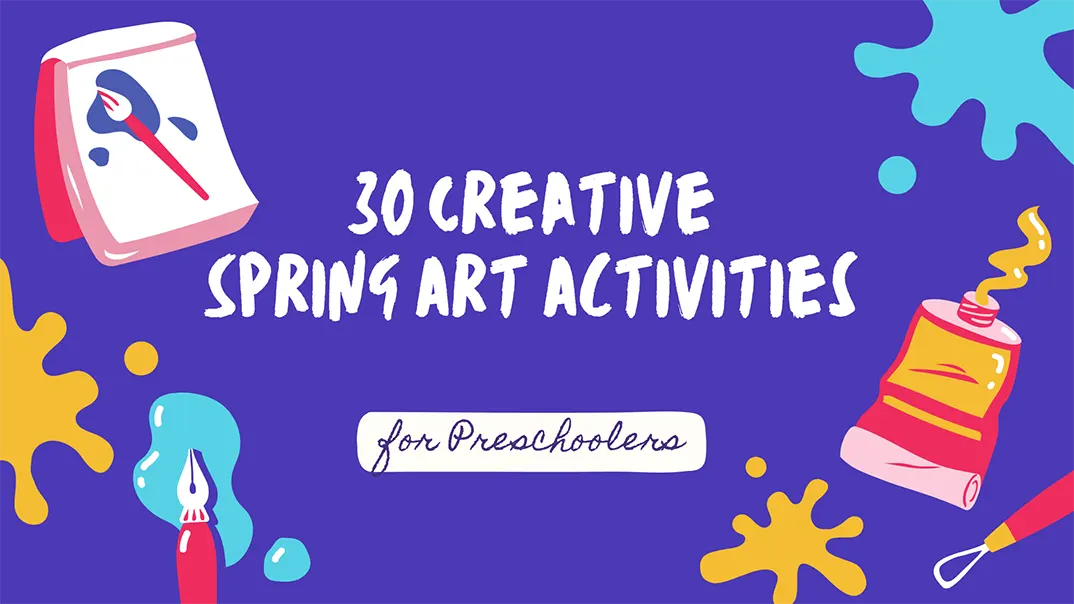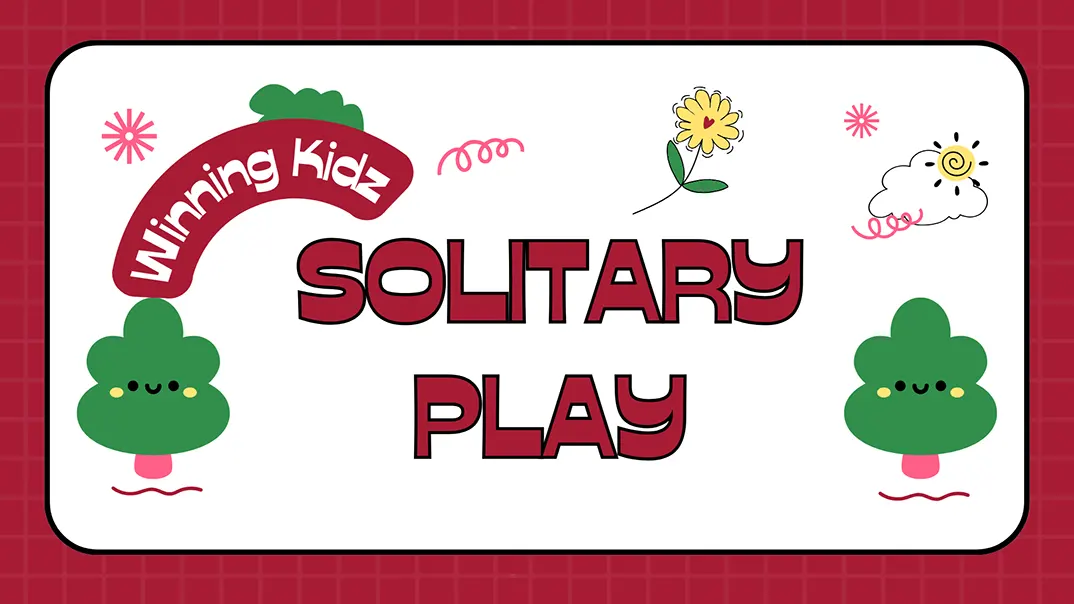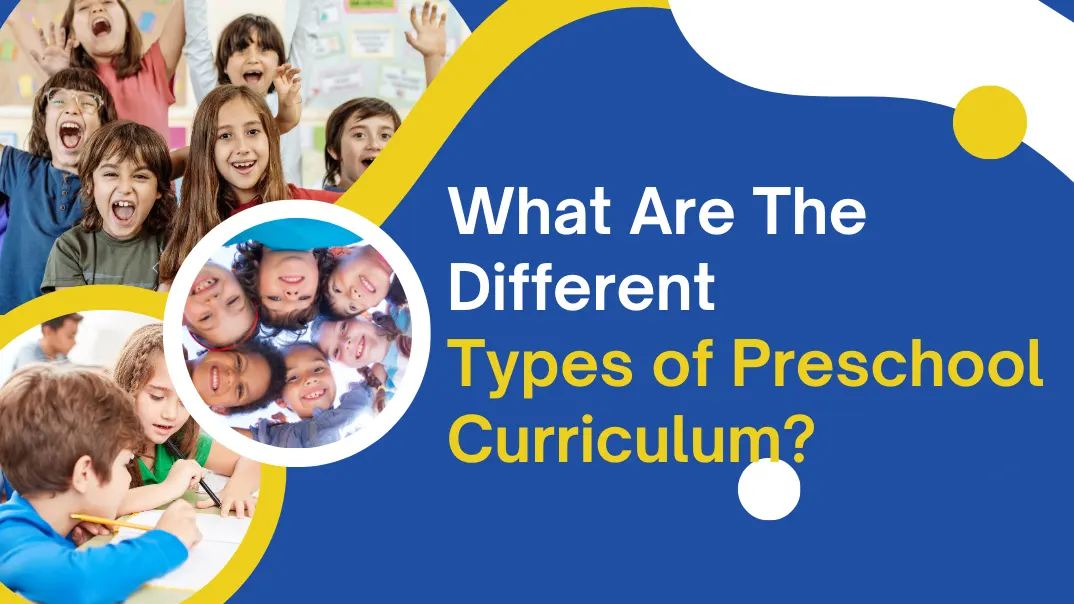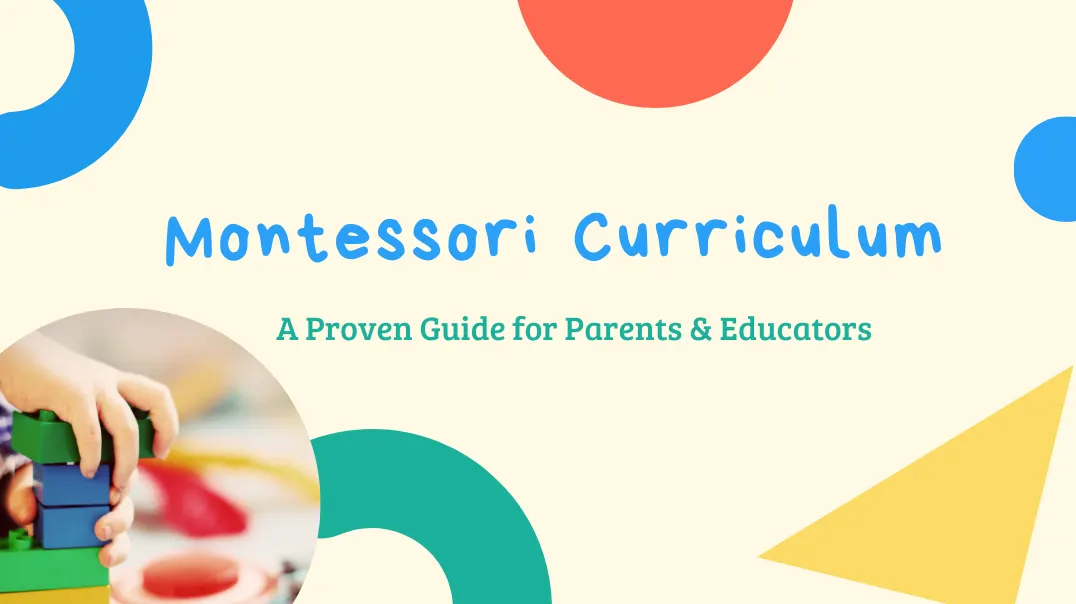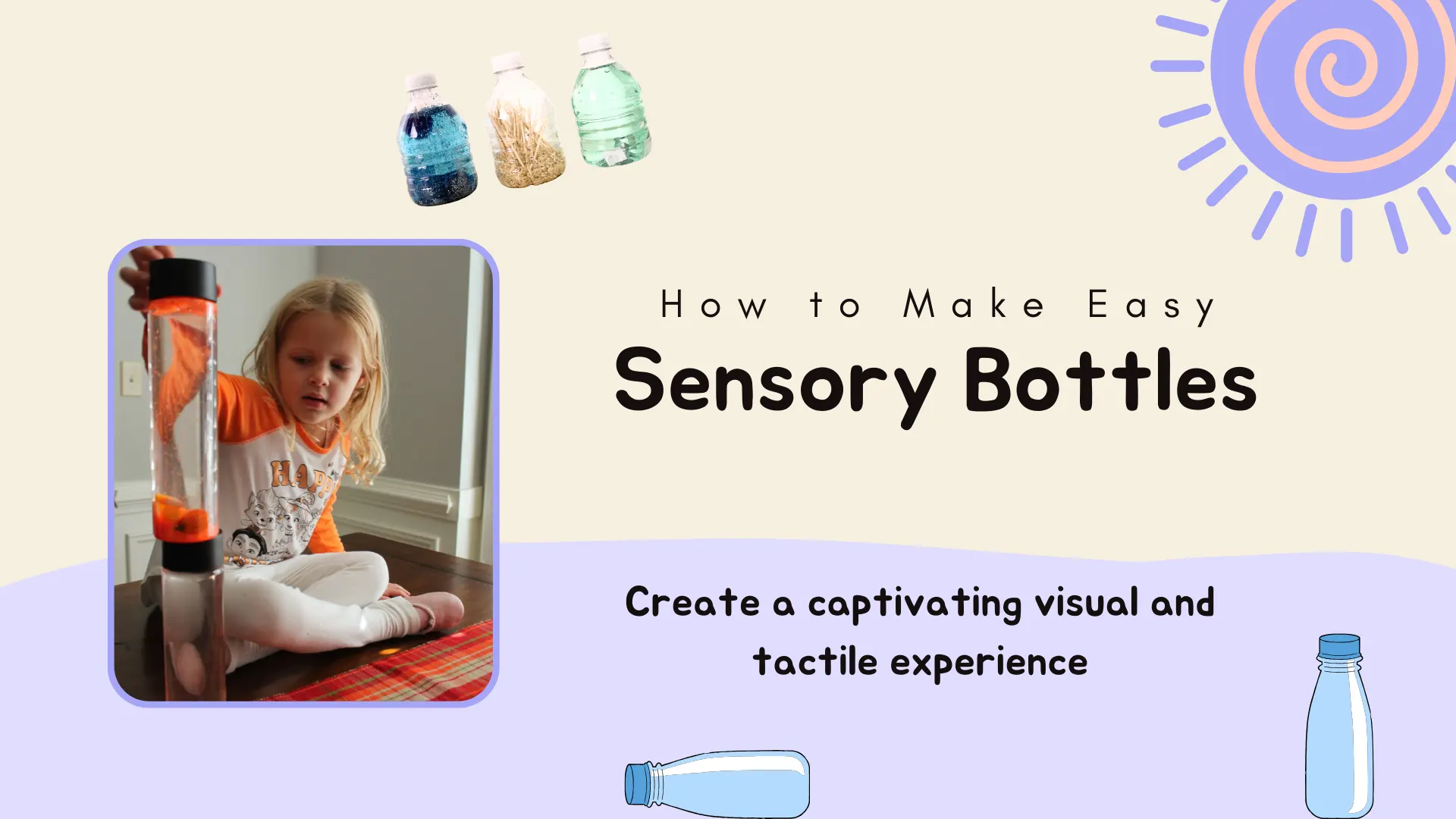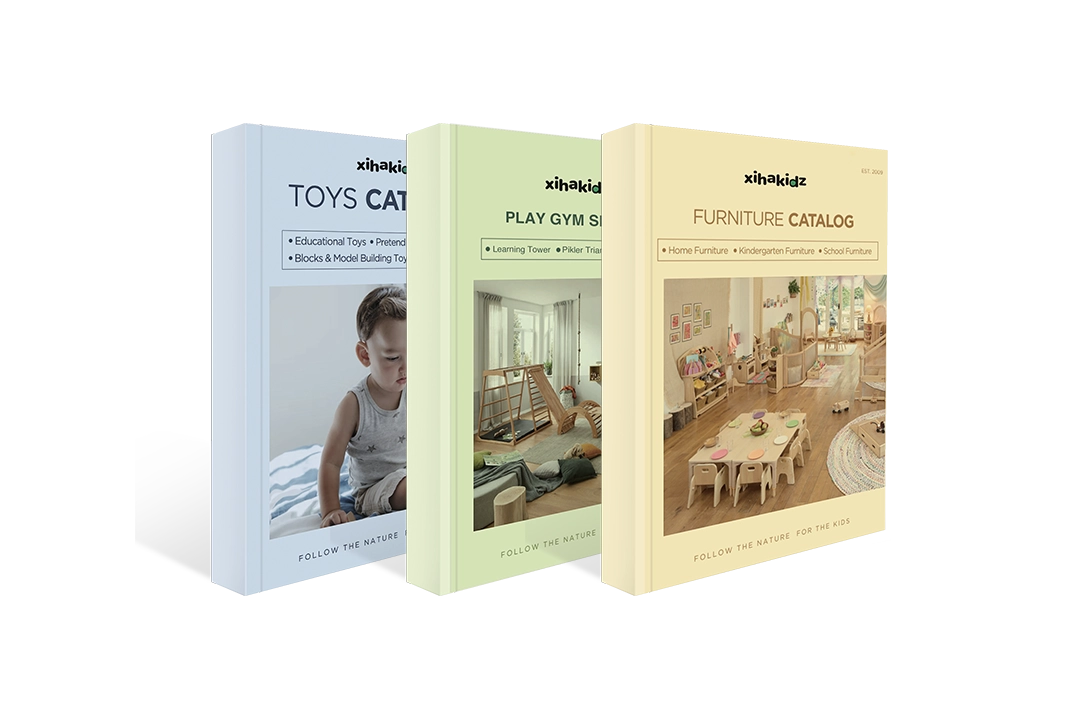As spring arrives with its vibrant colors and refreshing breeze, many parents and educators struggle to develop fresh, exciting ways to keep preschoolers entertained. How can you ensure your child enjoys fun, educational crafts that spark their imagination without repeating the same activities repeatedly?
Fortunately, we have the perfect solution! This article offers over 30 exciting spring-themed art activities ideal for preschoolers. These activities promote creativity, fine motor skills, and sensory exploration while keeping kids entertained. Whether crafting with natural materials or engaging in playful painting, these ideas will keep your child engaged and learning this spring.
From hands-on nature crafts to vibrant art projects, these spring art activities for preschoolers are designed to inspire and entertain and will help your preschooler develop their skills in a fun, seasonal way. Let’s explore these creative activities that will nurture your child’s imagination and keep them engaged all season long!
Benefits of Spring Art Activities for Preschoolers
Engaging preschoolers in spring art activities goes beyond just fun crafts; it offers a range of developmental benefits that contribute to their overall growth. Here are some of the key benefits of spring art activities for preschoolers:
1. Encourages Creativity and Imagination
Spring is a season of inspiration—blooming flowers, buzzing bees, and bright skies. Through various art projects, children can explore their imagination and express their feelings, ideas, and observations about the world around them. Whether they’re creating a painting of a garden or molding clay into spring animals, these spring art activities for preschoolers provide an outlet for self-expression and imaginative thinking.
2. Enhances Fine Motor Skills
Spring art activities for preschoolers, such as painting, cutting, gluing, or molding with clay, require precision and coordination, helping preschoolers develop fine motor skills. These activities involve small hand movements that strengthen the muscles in their hands and fingers, which is crucial for tasks like writing, buttoning shirts, and tying shoes in the future.
3. Boosts Problem-Solving Skills
Art often involves trial and error—deciding what materials to use, how to arrange elements, or how to bring an idea to life. Preschoolers learn to solve problems as they work through challenges in their art projects. They may decide how to mix colors, what tools to use, or how to fix mistakes, promoting cognitive development and decision-making abilities.
4. Promotes Sensory Exploration
Many spring art activities for preschoolers incorporate natural materials like leaves, flowers, or dirt, allowing children to explore textures, shapes, and colors. This sensory engagement is not only fun but also supports sensory processing development. It encourages them to notice the world around them, making connections between what they see, feel, and create.
5. Fosters Emotional Expression
Spring is a time of renewal; art can help preschoolers express emotions they might not yet have the words for. Children can communicate their moods through their artwork, whether a bright, cheerful drawing or a messy, abstract painting. This emotional expression fosters emotional intelligence and self-awareness.
6. Strengthens Social Skills
When preschoolers engage in art activities with others, they learn important social skills like sharing, taking turns, and collaborating. These spring art activities for preschoolers often occur in group settings, such as in a preschool classroom or with siblings, encouraging teamwork and cooperation. Discussing their creations with peers also helps children build their language skills and confidence in communicating their ideas.
7. Connects Children to Nature
Many spring art activities for preschoolers encourage outdoor exploration, from nature walks to collecting leaves or flowers for crafting. These activities help children connect with the natural world, fostering a sense of appreciation for the environment. They also provide opportunities for physical activity, which is vital for developing coordination and balance.
8. Boosts Confidence and Sense of Accomplishment
Completing an art project, whether a handprint flower or a painted butterfly, gives preschoolers a sense of pride and accomplishment. It reinforces their self-esteem and builds confidence, helping them feel capable and proud of their work.
Spring Art Activities for Preschoolers
Spring is a season of renewal, making it the perfect time to explore creative art activities with preschoolers. The vibrant colors, the blossoming flowers, and the fresh, warm air are all sources of inspiration for young children to express themselves through art.
1. Spring Art Activities for Preschoolers: Painted Flower Pots

Let preschoolers paint and decorate small terracotta flower pots. These can be personalized with bright colors, flower designs, or seasonal stickers. Once the pots are dry, plant some spring flowers or herbs, teaching kids about art and gardening.
Materials: Terracotta flower pots, acrylic paint, paintbrushes, stickers, or stencils
This activity combines creativity with learning about nature and responsibility. The finished product gives kids a sense of accomplishment as they care for their newly planted flowers.
2. Spring Art Activities for Preschoolers: Paper Plate Tulips

Have children color the center of a paper plate with bright colors to represent the petals of a tulip. Then, cut out leaves and a stem from green construction paper and glue them to the bottom of the plate. This simple craft mimics a blooming spring flower.
Materials: Paper plates, colored markers or crayons, green construction paper, scissors, glue
This activity helps preschoolers practice cutting and gluing, enhancing their fine motor skills while learning about one of spring’s most popular flowers.
3. Spring Art Activities for Preschoolers: Handprint Butterflies

Dip a preschooler’s hands in colorful paint and have them press their hands together on a piece of paper to create a butterfly’s wings. After the paint dries, they can draw on antennas and decorate the butterfly’s wings with markers or glitter.
Materials: Construction paper, paint (various colors), markers
These bugs’ art activities for preschool involve handprints as the main element, which is a wonderful way to engage young children in a tactile and fun way. It’s also an excellent introduction to the concept of symmetry.
4. Spring Art Activities for Preschoolers: Bird Collage

Cut out the shape of a bird from construction paper and let the child decorate it using colorful feathers, googly eyes, and crayons. Preschoolers can use their creativity to design a vibrant spring bird with lots of personality.
Materials: Construction paper, scissors, glue, feathers, googly eyes
This craft lets children explore texture with feathers while developing their scissors skills and hand-eye coordination. Plus, it’s fun to talk about birds and springtime wildlife.
5. Spring Art Activities for Preschoolers: Flower Pressing
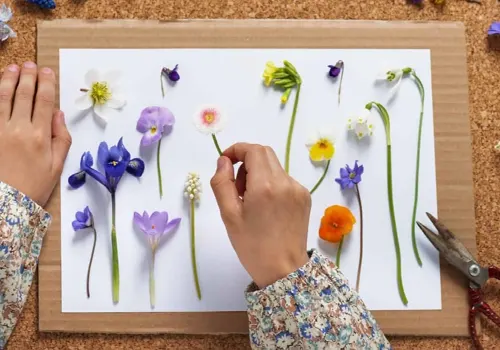
Collect fresh flowers during a nature walk, then place them between two sheets of wax paper. Press the flowers by placing heavy books on top for a few days. Once the flowers are dried and flattened, use them to decorate colored paper.
Materials: Fresh flowers, wax paper, heavy books, colored paper
Flower pressing teaches kids about the beauty of nature and gives them a hands-on way to preserve the colors and shapes of flowers. It’s also a calming activity that encourages patience.
6. Spring Art Activities for Preschoolers: Sun Catcher

Cut a shape out of contact paper. Peel the backing off and have preschoolers stick small bits of colorful tissue paper onto the sticky side. Once they’ve finished, seal the shape with another layer of contact paper. Punch a hole and add a string to hang it in the window.
Materials: Clear contact paper, tissue paper, scissors, string
Sun catchers are fun and easy for kids to make. They provide a sensory experience as they work with the textures of the materials. The colorful result will brighten any room and add some spring sunshine indoors.
7. Spring Art Activities for Preschoolers: Tree Collage

Cut out the shape of a tree trunk from brown construction paper and glue it to a larger sheet. Then, tear small pieces of green tissue paper to form the tree’s leaves and attach them to the top of the tree.
Materials: Brown paper, green tissue paper, glue, construction paper
This craft helps preschoolers with fine motor skills as they tear the tissue paper and glue it onto the page. It’s also a great way to discuss how trees change during spring.
8. Spring Art Activities for Preschoolers: Paper Flower Crowns

Have children cut out flower shapes from colorful construction paper and decorate them with markers. Then, glue the flowers to a strip of paper, which can be adjusted to fit around their heads. Attach an elastic string at both ends to secure the crown.
Materials: Construction paper, scissors, glue, markers, elastic string
This craft helps preschoolers with cutting and fine motor skills, and they can proudly wear their creations. It’s a fun way to encourage imaginative play with a springtime twist.
9. Spring Art Activities for Preschoolers: Animal Puppets

Use brown paper bags as the base for creating animal puppets. Preschoolers can decorate them with colored paper to create spring animals like bunnies, chicks, or lambs. Once decorated, they can put on puppet shows!
Materials: Brown paper bags, colored paper, glue, scissors, googly eyes
This activity combines crafting with imaginative play, helping preschoolers develop their creativity, social skills, and understanding of animals in the spring season.
10. Spring Art Activities for Preschoolers: Sensory Bottles
Materials: Clear plastic bottles, colored water, glitter, flowers, beads

Fill a plastic bottle with colored water, glitter, and small flowers or beads. Seal the bottle tightly and let preschoolers shake it to see the effects. Adding small items like bugs or leaves creates a nature-inspired sensory bottle.
Materials: Clear plastic bottles, colored water, glitter, flowers, beads
Sensory bottles are calming and engaging, helping preschoolers explore their senses while learning about the seasons and nature.
11. Spring Art Activities for Preschoolers: Egg Carton Flowers

Cut individual cups from an egg carton and let the children paint their bright spring colors. After the paint dries, attach a pipe cleaner to the stem and glue on green leaves made from construction paper.
Materials: Egg cartons, paint, scissors, pipe cleaners, glue
This activity encourages recycling and creativity while helping preschoolers practice fine motor skills by cutting and gluing different materials.
12. Spring Art Activities for Preschoolers: Collage with Seeds

Give children a piece of construction paper and allow them to create a collage using different types of seeds. They can glue the seeds onto the paper to form patterns, flowers, or abstract designs and use markers to add details.
Materials: Seeds (sunflower, pumpkin, etc.), glue, construction paper, markers
This project allows preschoolers to explore texture, color, and design while learning about the importance of seeds in nature and gardening.
13. Spring Art Activities for Preschoolers: Paper Bag Kite Craft

Turn a brown paper bag into a kite by cutting colorful construction paper into kite-shaped pieces and gluing them to the front of the bag. Attach a string to the bottom and let the children decorate it with markers, stickers, or other embellishments.
Materials: Brown paper bags, construction paper, glue, scissors, string
This craft encourages creativity while teaching preschoolers about springtime activities like flying kites. It’s also great for their fine motor skills as they decorate and assemble the kite.
14. Spring Art Activities for Preschoolers: Bird’s Nest Craft

Let preschoolers glue small twigs and string into a circular shape to form a nest on paper. Add cotton balls to simulate soft nesting material, and place small plastic eggs or beads inside the nest to complete the scene.
Materials: Twigs, string, glue, cotton balls, small plastic eggs or beads
This activity introduces children to the concept of birds and their nests while they practice crafting and fine motor skills.
15. Spring Art Activities for Preschoolers: Footprint Art

Dip the preschooler’s feet in paint and press them onto a large sheet of paper to create foot-shaped prints. Once the prints dry, use markers to turn the prints into spring animals, such as bunnies or flowers.
Materials: Paint, a large sheet of paper, markers
This fun, messy activity combines physical movement with creative expression, allowing kids to engage hands-on with the spring theme.
16. Spring Art Activities for Preschoolers: Painted Ladybug Rocks

Let the children paint rocks like ladybugs, using red for the body and black for the spots. After the paint dries, they can use the rocks to decorate a garden or give them as gifts.
Materials: Small, smooth rocks, red and black paint, paintbrushes
This craft promotes creativity and fine motor skills as children paint, and the painted rocks are a fun way to bring the outdoors into their artwork.
17. Spring Art Activities for Preschoolers: Tissue Paper Flowers

Stack several layers of tissue paper, cut them into flower shapes, and then twist a pipe cleaner around the center of the tissue to form a flower. Preschoolers can fluff the tissue layers to create a 3D flower effect.
Materials: Tissue paper, pipe cleaners, scissors, glue
This craft enhances fine motor skills and teaches about texture and layering, allowing children to create beautiful, colorful flowers.
18. Bee Art Activities for Preschoolers: Bee Fingerprint Art

Dip preschoolers’ fingers in yellow paint to create the body of a bee, then use a marker to add black stripes and wings. To complete the scene, they can also draw flowers or a hive around the bee.
Materials: Yellow and black paint, paper, markers
This craft introduces kids to the important role of bees in the environment while encouraging fine motor skill development through fingerprint art.
19. Spring Art Activities for Preschoolers: Animal Finger Puppets

Cut out animal shapes from felt, such as bunnies, chicks, or lambs. Preschoolers can glue the shapes together to create finger puppets. They can then add details like eyes, noses, and ears with markers.
Materials: Felt, fabric glue, scissors, markers
This activity fosters creativity and encourages imaginative play, allowing preschoolers to create puppet shows with spring-themed animals.
20. Spring Art Activities for Preschoolers: Clay Garden Sculptures

Give children some clay to mold and sculpt into flowers, insects, or other garden-themed figures. Once the sculptures dry, they can be painted bright colors to complete the garden scene.
Materials: Air-dry clay, paint, small tools
This hands-on activity develops creativity and fine motor skills and provides a tactile experience with clay that enhances sensory exploration.
21. Spring Art Activities for Preschoolers: Caterpillar Paper Roll Craft

Cut the toilet paper roll into smaller pieces and glue them together to form a caterpillar. Let children decorate each piece with different colors and add googly eyes to make the caterpillar come to life.
Materials: Toilet paper rolls, colored construction paper, glue, googly eyes
This activity teaches about the life cycle of a caterpillar while allowing children to develop their creativity and fine motor skills through decorating and assembling the craft.
22. Spring Art Activities for Preschoolers: Leaf Printing with Paint

Collect leaves and have children paint their undersides. Press the painted leaves onto paper to create a print. This activity allows children to explore textures and patterns found in nature.
Materials: Leaves, paint, paper
Leaf printing encourages the exploration of textures, shapes, and natural patterns while also promoting creativity through a hands-on art process.
23. Spring Art Activities for Preschoolers: Bug Hotel Craft

Help preschoolers gather small twigs, leaves, and pinecones, then glue them into a shoebox to create a bug hotel. The box provides a home for beneficial insects like ladybugs or bees in the garden.
Materials: Shoebox, twigs, leaves, pinecones, small natural items, glue
This craft introduces kids to the concept of biodiversity and helps them understand the importance of insects in the environment.
24. Spring Art Activities for Preschoolers: Paper Plate Butterfly Wings

Cut a paper plate in half and let preschoolers decorate each half with bright colors, shapes, and patterns to create butterfly wings. Attach the wings with a pipe cleaner to form a butterfly.
Materials: Paper plates, colored markers or paint, scissors, pipe cleaners
This craft enhances fine motor skills, encourages creativity, and allows children to create a butterfly they can wear or display.
25. Spring Art Activities for Preschoolers: Sunflower Handprint

Have children dip their hands in yellow paint and press them onto a sheet of brown construction paper to create the petals of a sunflower. Once dry, they can use brown paint or markers to add a sunflower center.
Materials: Yellow paint, brown paint, construction paper
Handprint art is a personal and fun way for preschoolers to create while learning about sunflowers’ growth and the spring season.
26. Spring Art Activities for Preschoolers: Nature Weaving

Cut a small piece of cardboard and create slits along the top and bottom. Preschoolers can weave colorful yarn through the slits and add twigs, leaves, and other natural items for decoration.
Materials: Cardboard, yarn, twigs, leaves, scissors, glue
This activity encourages fine motor skills and sensory exploration as children interact with natural materials to create an art piece.
27. Spring Art Activities for Preschoolers: Cloud and Rainbow

Have preschoolers glue cotton balls on paper to create fluffy clouds. Then, watercolor paints add a colorful rainbow arcing above the clouds.
Materials: Cotton balls, glue, watercolor paints, paper
This activity combines painting and tactile play, helping preschoolers develop creativity while learning about spring weather patterns.
28. Spring Art Activities for Preschoolers: Rain Stick Craft

Fill a cardboard tube with rice or beans, then tape both ends closed. Decorate the outside of the tube with markers or paper to create a colorful rain stick. Preschoolers can shake it to simulate the sound of rain.
Materials: Cardboard tube, rice or beans, tape, markers, paper
This craft teaches children about sound and rhythm while promoting creativity, fine motor skills, and an understanding of the weather.
29. Spring Art Activities for Preschoolers: Watering Can Craft

Cut out the shape of a watering can from construction paper and have children decorate it with markers, stickers, or patterns. They can then cut out paper flowers and glue them onto the watering can to create a spring garden.
Materials: Construction paper, scissors, glue, markers
This art activity helps preschoolers practice cutting and gluing while teaching them about gardening and the importance of watering plants during spring.
30. Spring Art Activities for Preschoolers: Paper Plate Rain Cloud
Materials: Paper plates, cotton balls, blue paint, glue, scissors

Cut a paper plate in half to create a cloud shape. Glue cotton balls onto the plate to represent the fluffy cloud. Preschoolers can then use blue paint to add raindrops hanging from the cloud.
Materials: Paper plates, cotton balls, blue paint, glue, scissors
This craft introduces the concept of weather while helping preschoolers practice gluing and painting skills.
Safety Considerations in Spring Art Activities for Preschoolers
While spring art activities are a fantastic way to engage preschoolers, it’s important to keep safety in mind to ensure that the children enjoy the creative process without any risks. Here are some essential safety considerations to keep in mind when doing spring-themed crafts and art projects:
1. Use Non-Toxic Materials
Always choose non-toxic, child-safe art supplies like paints, markers, and glues. Young children often put objects in their mouths, and using materials free from harmful chemicals ensures their safety. Check labels on art supplies to confirm that they are non-toxic and safe for preschoolers to handle.
2. Supervise
Many art projects, especially those involving nature, can include small items like buttons, beads, or seeds. While these can be exciting for kids to work with, they also present a choking hazard. Always supervise children closely when using small parts, and ensure they know not to put them in their mouths. Opt for larger, safer alternatives if necessary.

3. Keep Scissors and Sharp Objects Away
Safety scissors can be a great tool for arts and crafts for older preschoolers, but younger children should never be given access to sharp objects like regular scissors or knives. If you are using materials that require cutting, make sure to do the cutting for them or use child-safe tools under supervision.
4. Create a Safe Crafting Area
Before starting any spring art activity, prepare the space. Use a clean, well-ventilated area with plenty of room for children to move around safely. If you’re working outdoors, ensure the ground is stable and free of hazards like sharp objects or uneven surfaces. Lay down a protective covering, like a plastic sheet or newspaper, to make cleanup easier and avoid staining surfaces.
5. Protect Clothing and Skin
Art supplies like paint, glue, and markers can be difficult to remove from clothing. Consider providing aprons or old shirts for kids to wear while crafting to protect their clothes. Additionally, it’s a good idea to have baby wipes or a damp cloth on hand to quickly clean hands and skin in case of spills or smudges.
6. Avoid Harmful Natural Materials
If you’re using natural materials like flowers, leaves, or twigs for crafts, ensure they are safe and non-toxic. Some plants can be harmful if touched or ingested. For example, avoid using poison ivy or unknown plants that could cause allergic reactions or skin irritation. It’s always a good idea to familiarize yourself with common safe plants and their potential risks.
7. Ventilate the Area When Using Paints or Glue
Certain art materials, especially spray paints or strong adhesives, can release fumes that may not be suitable for children. If using these materials, ensure the area is well-ventilated by opening windows or using fans. For safer alternatives, choose water-based paints and low-VOC (Volatile Organic Compounds) adhesives designed for children.
8. Be Mindful of Allergies
Spring often brings a surge of pollen and allergens into the environment, which can trigger allergic reactions in children, especially when doing nature-inspired projects. If you’re going on a nature walk or collecting items from outdoors, check for any potential allergies (such as pollen, mold, or certain plants). If unsure, limiting outdoor activities or sticking to indoor projects is safer.
9. Clean Up After Each Activity
Safety doesn’t stop when the craft is done. Be sure to clean up any leftover preschool supplies and materials. Teach children the importance of tidying up after themselves to avoid any potential accidents, such as slipping on wet paint or knocking over containers of supplies. Storing supplies properly in child-safe containers also reduces the risk of accidental exposure.
10. First Aid Readiness
Accidents can happen, even in the most carefully planned spring art activities for preschoolers. Keep a basic first aid kit nearby with essentials like band-aids, antiseptic wipes, and allergy medication. In case of any cuts, scrapes, or allergic reactions, it’s essential to be prepared to handle minor injuries promptly.
Adapting Activities for Different Skill Levels
When working with preschoolers, it’s important to recognize that children develop at different rates and possess varying skill levels. As an educator or parent, it’s essential to adapt art activities to meet each child’s needs and abilities. This ensures that every child can participate, learn, and enjoy the creative process, regardless of their developmental stage.

For Beginners: Simplified Spring Art Activities for Preschoolers
For preschoolers just beginning to develop their fine motor skills or who need extra support, simplified activities with fewer steps and larger, easier-to-handle materials are key.
Example: Flower Stamps Using Real Flowers
- Simplified Version: Use larger flowers (such as sunflowers or roses) with sturdy petals, making it easier for children to dip them into paint. You can also pre-cut flower shapes for the child to stamp, allowing them to focus on the stamping process rather than cutting or handling intricate materials.
- Adaptations: For beginners, pre-dip the flowers in paint so they can focus on pressing them onto the paper without worrying about applying the paint themselves. Use larger sheets of paper to give more room for exploration.
For Intermediate Skill Levels: Encouraging Creativity
For preschoolers who have more developed fine motor skills and an understanding of basic art processes, it’s beneficial to introduce slightly more complex tasks that encourage creativity and independence.
Example: Painted Ladybug Rocks
- Intermediate Version: Provide smaller rocks and encourage children to paint detailed patterns, such as smaller spots or faces on the ladybug, without pre-marking them. Let the child decide how to decorate the ladybug and introduce additional design elements like leaves or flowers around the bug.
- Adaptations: Allow preschoolers to choose different colors for the ladybug’s body and spots or suggest adding antennae or wings. This gives them creative control while still developing fine motor skills through painting and precision.
For Advanced Skill Levels: Enhancing Complexity and Detail
For preschoolers who have developed strong motor skills and are ready to experiment with more intricate techniques, the goal is to challenge their abilities and encourage them to refine their artistic expressions.
Example: Butterfly Watercolor Resist Art
- Advanced Version: Instead of just outlining a basic shape, encourage children to create more detailed butterfly wings with intricate patterns and textures. Use different watercolor techniques, like wet-on-wet or dry brushing, to create more depth and variation in their butterfly art.
- Adaptations: Allow preschoolers to add multiple layers of paint, create additional designs around the butterfly, or even combine two butterflies in one artwork. Provide detailed feedback and support as needed, encouraging them to think critically about colors and composition.
For Children with Special Needs: Tailoring to Support Development
Art activities can be particularly beneficial for children with special needs, as they promote fine motor development, creativity, and self-expression. Modifying activities to meet their needs ensures they can participate fully and meaningfully.
Example: Paper Plate Butterfly Wings
- Adaptations: For children with motor difficulties, use pre-cut butterfly wing shapes and allow them to decorate with stickers, large crayons, or sponges instead of using small paintbrushes. Provide hand-over-hand support or use adaptive tools like thicker crayons or pencils for better grip.
- Use Sensory Materials: Incorporate sensory-friendly materials like textured fabrics, soft paper, or glitter foam to make the activity more engaging and comfortable for children with sensory processing challenges.
Conclusion
Spring art activities provide a wonderful opportunity for preschoolers to explore their creativity, develop fine motor skills, and learn about the world around them. By adapting activities to suit different skill levels, we ensure that every child can engage in meaningful and enjoyable creative experiences regardless of their developmental stage. Whether they are beginners, intermediate learners, or advanced students, each child can benefit from the hands-on exploration of art.
Discover Our Full Range of Products
Get access to our comprehensive catalog featuring top-quality furniture and play equipment for kindergartens and schools.

